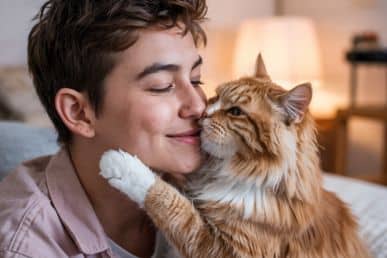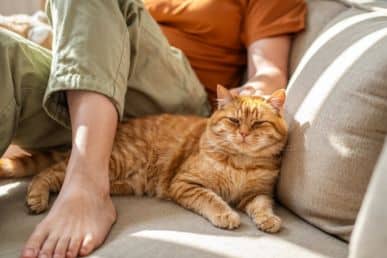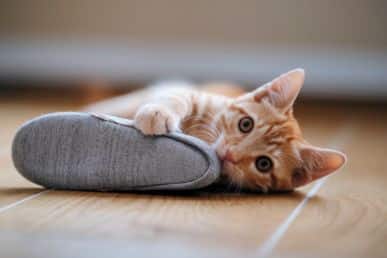How to make your cat more affectionate? Proven Ways

Does your cat sometimes act like a mysterious furball that’s more aloof than affectionate? Don’t worry—How to make your cat more affectionate isn’t about turning your shy kitty into a velcro-cat overnight.
It’s about learning their secret language! Start by watching their quirks: slow blinks, head-butts, or a rumbling purr mean they’re comfy.
Avoid forced hugs—instead, offer gentle chin scratches or sit nearby during calm moments. Patience is key! While kittens bounce between playful zoomies and sleepy snuggles, older cats often need a gentler approach.
Focus on trust-building. Use meals and playtime as reward moments to bond. Spend weeks letting them decode you—no rushing! With time, even the shyest furball might surprise you—curling up on your lap, purring, and claiming you as their favorite human.
Ready to decode your cat’s love language and turn those aloof vibes into purr-filled cuddles? Let’s dive into the step-by-step secrets—your lap might just become their new favorite throne.
Understanding Why Some Cats Resist Affection

Cats are masters of cuteness, from their snoozing poses in sunlight to their too-cuteness that makes it hard to resist their charm.
But according to cat behaviorists, many clients come to consultations with a common problem: their cats start avoiding their owners after too much well-meaning affection.
Trying to pet their belly or pick them up when they’re relaxed might seem sweet, but forcing affection can leave cats feeling uncomfortable or annoyed.
Understanding your cat’s evolution helps! They weren’t creators of cuddly habits—independence is in their genes.
A cozy cat tree or sunny spot might be their happy place, not your lap. Forced affection, like holding them when they squirm, breaks trust. Over time, this detriment weakens the human-cat bond, making them hide.
The good news? Early-life handling matters! Kittens handled extensively in their first few months often grow up friendlier. But this doesn’t mean forced affection—let them approach you.
Avoid the temptation to smother them; patience builds a bond stronger than any inability to resist those adorable eyes.
How Do Cats Express Affection Differently?
Cats show affection by sitting near you, not always wanting to be petted. Never force affection—wait for their consent to build trust.
Anecdote: In households with a cat-allergic partner, cats often choose the person with calm energy.
If annoyed, give space. Ignoring them gently appeals to their confidence, strengthening your relationship through respect.

Step-by-Step Guide to Making Your Cat More Affectionate
Building Trust Through Positive Associations
If your cat avoids staying within your arm’s reach, don’t worry! Start by lying near them without forcing interaction.
Cats might suspect your intentions if you keep accosting them, so always ask for consent, like gently offering a hand to sniff. Withholding too much attention (even if their too-cuteness is irresistible!) helps them feel safe.
To speed up the process, mix positive associations with your presence. Try these bonding activities:
- Keep cat treats in a sealed container—shake it once or twice a day to call her over when you’re sitting down. Reward her with a treat when she comes, but don’t overdo it.
- Use short clicker training sessions or fun play sessions to build trust. If she responds well, reward her!
- Spend quiet time together in the lounge, letting her decide when to approach.
Over a month of regular, consistent effort, your cat realises that spending time with you means good things.
The Consent Test: Respecting Your Cat’s Boundaries

Cats, like people, have their own rules for affection. Imagine if someone suddenly hugged you without asking—you’d feel uncomfortably handled, right? That’s why cat expert Jackson Galaxy suggests the Consent Test.
Start by slowly extending your hand towards their nose (the Finger-Nose technique). Let them sniff your fingers—if they rub their face or lean in, they’re saying “yes!” If they turn away or show indifference, respect that.
My cat Michelangelo taught me this: forcing pats when he’s not ready breaks trust. When soliciting cuddles, always check their mood. For example, sit near them but don’t push—let your cat approach you.
If they walk off, let them. One rule I live by: never move your arms or legs to trap them. Instead, gently move your hand towards their legs and pause. If they push into your palm, they’re saying, “enough love for now.”
Some cats show affection in strange ways, like licking you and then giving you a playful bite, which can confuse even experienced cat owners.
This builds a bond because you’re their safe guardian, not a scary giant. Cats show love on their terms. If Michelangelo’s busy staring at something outside, I don’t interrupt.
But when he decides to curl up beside me, I know we’ve strengthened our bond. Remember, fear disappears when they feel in control. Let them enjoy your presence without pressure—it’s the secret to a happy cat life!
Slow Blinks: A Sign of Trust
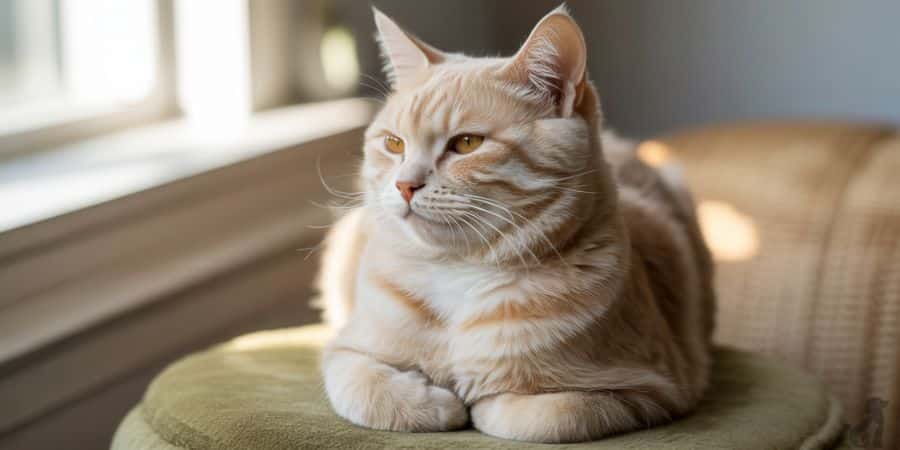
Research shows that slow blinks are associated with a positive emotional state in cats. When your cat gives you a slow blink, it’s a sign of trust and contentment, kind of like a human smile.
If you return the blink, it’s like giving them a compliment! This simple act helps bond with your cat and shows affection without needing to touch them, perfect for cats who aren’t keen on being picked up or cuddled.
Not all cats love being touched, but many are keen to connect in quieter ways. Try sitting near your cat and blinking back slowly. Over time, this nice way to communicate can make your cat feel safer and more loved.
Remember, cat behavior is similar to building a friendship, one gentle gesture at a time!
Be Present for Playtime
Want your cat to be more affectionate? Playtime isn’t just fun—it’s bonding time! Cats (yes, even kittens!) love when humans get directly involved. Try sitting face-to-face and using hand-to-paw games, like gently wiggling a string.
This personal engagement shows you care. Invite family members to join, too! When everyone engages in a friendly way, your cat feels safe and trusts you more.
Pro tip
Keep it light, silly, and let your cat “win” sometimes—it’s how they learn to see you as a friend!
How Playtime Helped My Shy Cat Love Cuddles
My cat Whiskers was always hiding under the bed—until I tried a feather wand toy. I’d wiggle it near his hiding spot, letting him play without forcing him. At first, he’d paw at it shyly.
Slowly, he started following the toy out into the room, tail wagging excitedly. Now, after playtime, he lies down next to me, purring loudly. Who knew a 12-year-old cat could become a cuddlebug?
So, Playtime isn’t only for kittens. Even older cats can learn to bond through fun!”
Curious to see more proven techniques on how to make your cat more affectionate? Watch this video covering 10 scientifically backed ways to deepen your bond with your cat:
Reward Good Behavior to Raise an Affectionate Cat
Kittens are naturally cuddly, but they can get naughty when bored! If your cat tries to bite or scratch, stay calm—never yell. Instead, redirect their energy to a toy or scratching post.
This teaches them what’s okay without making them feel angry or scared. I’ve found that encouraging them to play freely in a kitten-proof home (like hiding wires) aligns with their natural cat inclination to explore while keeping them safe.
Create designated quiet places for your cat to rest when they’re overwhelmed. After fun playtime, reward calm behavior with affection or a special treat.
For example, when my kitten behaved well, I’d give her a tiny piece of chicken! But avoid too many treats—stick to 10% of their daily caloric intake (like 1-2 bites) to prevent them from becoming overweight.
The other 90% should come from highly nutritious kitten food to keep them healthy and happy.
Socialise and Condition Early

“To help your cat become more cuddly, start by avoiding isolating kittens too early. Wait until they’re at least 8 weeks old and fully weaned before separating them from their mom.
Once they’ve had their vaccinations, gently include them in social interactions with people and calm animals like cat-friendly dogs. This helps them grow into confident adults who see humans and other pets as friends, not threats.
Invite family or trusted friends over regularly to contribute to their comfort around others. Create a home environment that feels safe. Use toys, boxes, and other safe objects during playtime to build trust.
Keep loud noises like the vacuum or noisy activities to a minimum—try soft play music instead. Stay personally involved by sitting quietly near your cat, letting them approach you.
Over time, this reduces their instinctive fear and turns them into peaceable companions who enjoy your company!”
Create a Cat-Friendly Space to Build Trust
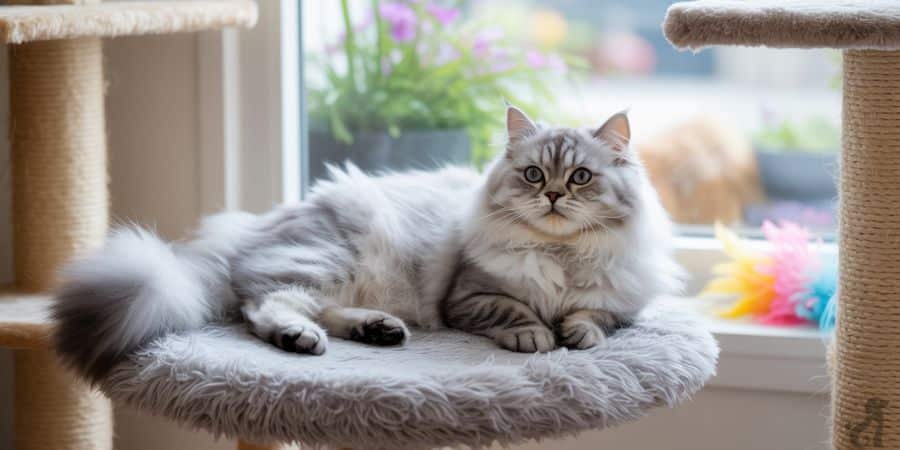
Want your cat to love hanging out with you? Start by making your home a cat-friendly paradise!
Cats need spots to climb, play, and chill out—think multi-tiered cat activity trees (like a jungle gym for cats!) or a simple cardboard box in the living room. Add scratching posts so they can sharpen their claws and leave their mark.
Don’t splash cash on fancy mod cons. A cool pad could be a cozy paw hut or a penthouse shelf where they can hide and feel safe. Cats love small spaces—try placing a box near your feet as a hiding spot.
Buy a few toys they can launch at or bat around. Place key resources like food, water, and adequately sized litter trays in quiet areas. Cats feel at home when they have access to these without feeling watched.
As cat behaviourist Jackson Galaxy says, catification (making your home fun for cats) helps them feel safe and independent. When they trust their space, they’ll want to hang out with you more!
Don’t Treat Your Kitten Like an Adult
Kittens aren’t tiny adults—they need around-the-clock care like a baby! If you’re raising a younger kitten (under 8 weeks), they might still rely on you to bottle-feed them kitty formula every 3 hours, just like their mom would.
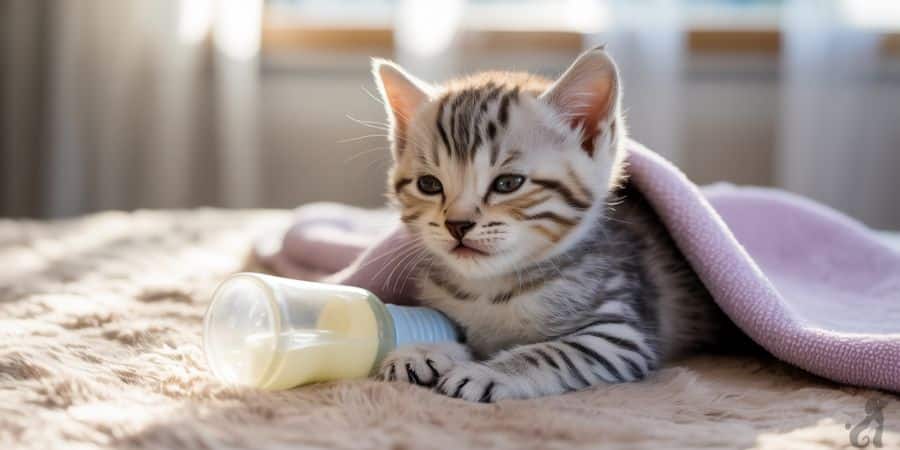
This helps build trust and makes them see you as their human parent. Use a warm cloth to keep warm and gently stimulate bowels after feeding—this mimics what their mother or siblings would do.
As they grow, wean them onto solid foods through a gradual process. Check an infographic on feeding stages to understand cat nutrition better. Don’t rush this—their tiny body and immune system are still developing!
Keep their space clean and separate from older cats or other pets until they’re stronger. Kitten vaccinations are also key for good health.
Nurture your kitten with patience. Spend time cuddling them daily so they learn to link you with safety. Pay attention to their developmental stages—what works for a 4-week-old won’t suit a 12-week-old!
By giving appropriate care now, you’ll raise a confident, affectionate cat who feels loved.
Keep Your Kitten Healthy
Want a cuddly cat? Start by keeping your kitten healthy! Good nutrition is the base for their growth and development—think of it as fuel for playtime and purrs.
A balanced diet helps them feel their best, so they’re more likely to act sweet. Don’t skip preventative veterinary care like vaccinations and deworming; these keep tiny troubles away.
Your cat’s behaviour is a big indicator of their health. If they feel under the weather, they might hide or ignore you. To raise an affectionate buddy, socialise them early with gentle play and praise.
The secret? Happy, healthy kittens grow into loving cats who trust you!
Gentleness Breeds Gentleness
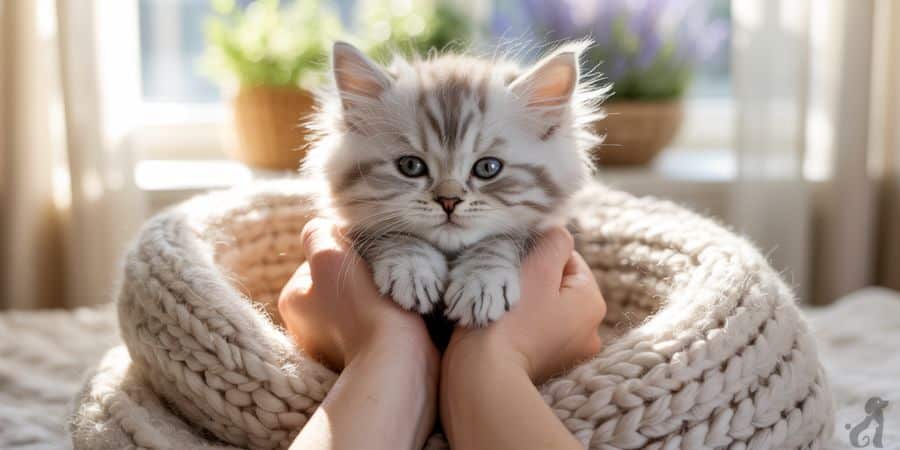
If you want your kitten to grow into a loving and affectionate cat, it all starts with how you treat them. Even if your cat is only a few weeks old, it’s already learning how to interact with others, whether they are animals or humans.
So the way you act around your kitten helps shape how they act in return. If you show gentleness, your cat will likely grow up with the same gentle nature.
Try these simple tips to help your kitten feel safe and loved:
- Cuddle frequently in a warm, cozy place. Your kitten will feel protected and loved.
- Pet affectionately using a soft voice, and say its name often to help build trust.
- Keep your kitten groomed, and make sure it’s brushed and cleaned. This helps your cat feel comfortable and cared for.
- As your kittens get older and more energetic, they’ll have extra energy to spare. That’s when frequent playtime becomes really important.
- Let them socialise and interact with the humans in your home, so they feel part of your family.
When you give love and care early on, your cat will stay close and bond with you for life.
Why It’s Okay If Your Cat Isn’t Affectionate Yet?
Your cat might not always seek cuddles, but that doesn’t mean they dislike you!
Explaining their behavior helps: Cats often show love quietly. Some cats bond quietly by sleeping near your legs. Build trust by spending time near them without trying to force interaction.
Refraining from non-solicited hugs lets your cat choose when to connect. Remember, bonding begins slowly—you’ve been told cats are independent, but patience turns you into their trusted guardian.
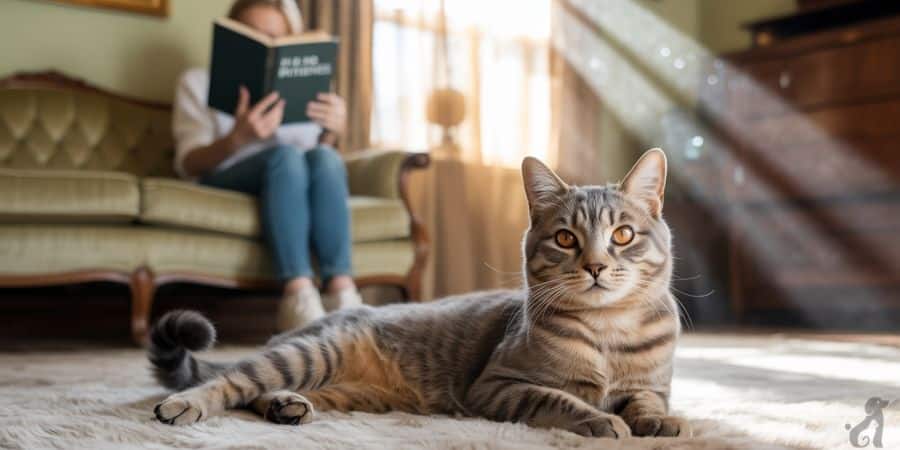
When Your Cat Says ‘That’s Enough!’ to Affection?
Cats aren’t like dogs—they have their own rules for affection. Imagine your cat has a tiny “patting meter” in their brain.
If you push them past their threshold limit (which is often a low sensitivity threshold), they may bite any part of your body, such as your nose, or they may stop interacting with you.
This is called petting-induced aggression. To tell the difference between “I want affection” and “I’m done!”, watch their body language.
If they’re curled up near you, they might enjoy gentle strokes. But if they flick their tail, getting up, or leaving, respect their space—they feel accosted.
Try the Consent Test: Slowly offer your hand. If they rub against it, they’re saying “yes!” If they turn away, they’re saying “no, thanks.” Always let your cat set the terms for cuddles.
- Cats show love on their schedule.
- Never force patting—it breaks trust.
Conclusion
Learning how to make your cat more affectionate requires patience, respect for their boundaries, and positive reinforcement. Prioritize trust-building through playtime, slow blinks, and the consent test.
Reward calm behavior and let your cat set the pace. While not every feline becomes a lap-lover, understanding their unique needs strengthens your bond, turning wary kitties into confident, loving companions over time.
Frequently Asked Questions
Why is my cat not affectionate?
Your cat’s level of affection is influenced by their individual personality and breed. Some cats are naturally independent and prefer to maintain distance from others. If they had limited early socialization or negative experiences, they might feel hesitant about being touched. Also, check for medical factors—discomfort can make them less cuddly. Every cat is different, so respect their space while gently encouraging bonding!
How do I make my cat more cuddly?
Focus on building trust through gentle interactions—slow blinks or soft petting. Encourage positive associations by offering treats when your cat snuggles. Keep play sessions consistent and fun to provide energy release. Rewarding affection with calm praise helps! Provide a comfortable, stimulating environment (think cozy beds or window perches). Always respect boundaries, allowing your cat to approach you on their terms. With patience, even the shyest kitty can grow cuddly!
How do I get my cat to bond with me more?
The key to building a strong bond with your cat is to give them sincere attention every day. Pet them gently when they want it, and talk softly to show you care. Watch their signals—if they walk away, don’t force things. Keep trying small moments, like playtime or treats, but don’t be pushy. Cats love moment-to-moment joy, so focus on things they like. If your cat doesn’t enjoy something, respect that!
Can a non-cuddly cat become cuddly?
Yes, but it’s a process needing patient effort. It might take several weeks or even a year—celebrate modest improvements like sitting closer. Never attempt to hurry things along or come on too strong; force the issue, and they’ll retreat. Instead, allow them to feel safe. Use food and gentle petting to provide positive links to affection. Be grateful when they’re drawn to you—no vacuum of pressure!
Is it bad to force your cat to cuddle?
Forcing your cat to cuddle might seem kind, but it’s bad for their well-being. Cats dislike being held or snuggled against their will—it can negatively impact their trust in you. Over time, this behavior might worsen, causing fear or mistrust. The reason? Cats need time to change on their terms.
Why does my cat cuddle at night but ignore me during the day?
Cats are naturally active at dawn and dusk, which means your furry friend might be busy exploring or guarding their space during the day. At night, when things are calm, they seek warmth and feel safe to choose you for a snuggle. Showing patience when they’re independent builds trust, helping them grow closer to you over time.
Can an older cat become affectionate, or is it too late?
Absolutely! Older cats can learn to love cuddles with gentle care and patience. Start slowly—offer tasty treats and speak softly to build trust. Keep a calm routine so they feel safe. Let them come to you instead of forcing hugs, especially with shy cats. With time, even the most reserved kitty can grow friendlier and enjoy your company!
My cat bites when I stop petting it. What does this mean?
If your cat bites when you stop petting, they might be saying they want more! Watch their tail – if it flicks or their ears are flattened, they’re getting annoyed. Pet them briefly, then stop before they’re done. Wait for a gentle nudge to continue. Teach them that biting isn’t needed by rewarding calm behavior with treats or praise.
How do I bond with a rescue cat with trauma?
Building trust takes time. Start by creating a quiet spot where your cat feels safe. Keep the same routine every day—consistency helps them learn to relax. Let them hide if they’re scared; don’t force hugs. Use toys like feather wands to play gently. Be patient; it might take weeks or months for them to open up.
Why does my cat sit NEAR me but not ON me?
Cats show love by staying close, like on your bed or a cozy blanket—but their independence means they might skip your lap. They feel safe near you, even if cuddling isn’t their style. It’s their way of saying, “I like you!” without being too clingy.

